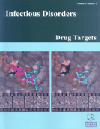- Home
- A-Z Publications
- Infectious Disorders - Drug Targets (Formerly Current Drug Targets - Infectious Disorders)
- Previous Issues
- Volume 8, Issue 1, 2008
Infectious Disorders - Drug Targets (Formerly Current Drug Targets - Infectious Disorders) - Volume 8, Issue 1, 2008
Volume 8, Issue 1, 2008
-
-
Preface [ Infectious Disorders Drug Targets - An Arsenal of Knowledge on Pathogen Targets ]
More LessMost of the actions of estrogens are mediated by two isoforms of the estrogen receptor (ER) encoded by different genes, ERαand ERβ, which were cloned in 1986 and 1987, respectively. Both receptors function as ligand-dependent transcription factors to regulate gene expression according to the classical estrogen signalling pathway. However, estrogen signalling seems to be more complicated than the genomic pathway becau Read More
-
-
-
Genomic and Genetic Approaches for the Identification of Antifungal Drug Targets
More LessAuthors: A. K. Agarwal, T. Xu, M. R. Jacob, Q. Feng, X. C. Li, L. A. Walker and A. M. ClarkUnderstanding how novel antifungal compounds work in target cells is useful not only in facilitating the discovery of new drugs but also new tools that can be used for further exploration of the targeted biological pathways and their regulation. Various genomic and genetic technologies have been developed in the model yeast Saccharomyces cerevisiae, and have been successfully used to identify drug target pathways. This r Read More
-
-
-
Structural Analysis of Farnesyl Pyrophosphate Synthase from Parasitic Protozoa, a Potential Chemotherapeutic Target
More LessSynthesis of farnesyl pyrophosphate (FPP), a key intermediate of the isoprenoid biosynthesis pathway, is catalyzed by FPP synthase (FPPS). Antiprotozoal properties of bisphosphonates, which target FPPS, have generated interest in FPPS as a potential antiprotozoal drug target. The genes encoding FPPS from parasitic protozoa were assessed to analyze structural and functional features of the enzyme. Comparisons Read More
-
-
-
The Use of Proteomics to Study Infectious Diseases
More LessAuthors: E. O. List, D. E. Berryman, B. Bower, L. Sackmann-Sala, E. Gosney, J. Ding, S. Okada and J. J. KopchickTechnology surrounding genomics, or the study of an organism's genome and its gene use, has advanced rapidly resulting in an abundance of readily available genomic data. Although genomics is extremely valuable, proteins are ultimately responsible for controlling most aspects of cellular function. The field of proteomics, or the study of the full array of proteins produced by an organism, has become the premier arena for Read More
-
-
-
Editorial [ Infectious Disorders Drug Targets - An Arsenal of Knowledge on Pathogen Targets ]
More LessInfectious disorders have always received special attention due to their global importance in human health. Recently this area has been in special focus due to increased global biological threats, bioterrorism and prominent media coverage given to some recent infectious disease epidemics [1, 2]. Global climate changes have also led to an increased risk of infectious diseases [3]. Reemergence of the infectious diseases and cont Read More
-
-
-
Relationship Between Non-Genomic Actions of Estrogens and Insulin Resistace
More LessAuthors: Ana Alonso and Celestino GonzalezNumerous experimental and clinical data show that the physiological actions of insulin and sexual steroids interact in target tissues for these hormones. In the other hand, sexual steroids has effects on peripheral tissues, and since the skeletal muscle is the main responsible for peripheral glucose uptake, it would be possible that the sexual steroids induce directly in the muscle a decrease of the sensibility of this tissue to ins Read More
-
-
-
Estrogen Regulation of Adipose Tissue Functions: Involvement of Estrogen Receptor Isoforms
More LessAuthors: V. Pallottini, P. Bulzomi, P. Galluzzo, C. Martini and M. MarinoAdipose tissue has recently been described as one of the major endocrine gland that plays a role in energy homeostasis, lipid metabolism, immune response, and reproduction. An excess of white adipose tissue, caused by a complex interaction between genetic, hormonal, behavioral, and environmental factors, results in obesity: a heterogeneous disorder that predisposes humans to a variety of diseases. Among several ho Read More
-
-
-
Rapid Regulation of Pancreatic α- and β- Cell Signalling Systems by Estrogens
More LessAuthors: Cristina Ripoll, Ana B. Ropero, Paloma Alonso-Magdalena, Ivan Quesada, Esther Fuentes and Angel NadalRapid estrogen actions are triggered after estrogens are bound to a variety of proteins in organelles other than the nucleus. Those include classic estrogen receptors ERα and ERβ, novel membrane proteins that behave as estrogen receptors such as GPR30, ion channels, and other ligand receptors. In pancreatic α and β-cells, estrogens binding to a non-classical membrane estrogen receptors at physiological concentration Read More
-
-
-
Neuroprotective Effects of Estrogens: Cross-Talk Between Estrogen and Intracellular Insulin Signalling
More LessAuthors: Celestino Gonzalez, Fernando Diaz and Ana AlonsoThe incidence of neurodegenerative diseases is higher in postmenopausal women that young women. In this sense, Alzheimer's and Parkinson's diseases, ischemic brain injury and memory or cognitive dysfunction increase dramatically when the ovarian function declines. On the other hand, insulin resistance represents an independent factor in the etiology of age-associated coronary and cerebrovascular disease. Therefore, Read More
-
Volumes & issues
-
Volume 25 (2025)
-
Volume 24 (2024)
-
Volume 23 (2023)
-
Volume 22 (2022)
-
Volume 21 (2021)
-
Volume 20 (2020)
-
Volume 19 (2019)
-
Volume 18 (2018)
-
Volume 17 (2017)
-
Volume 16 (2016)
-
Volume 15 (2015)
-
Volume 14 (2014)
-
Volume 13 (2013)
-
Volume 12 (2012)
-
Volume 11 (2011)
-
Volume 10 (2010)
-
Volume 9 (2009)
-
Volume 8 (2008)
-
Volume 7 (2007)
-
Volume 6 (2006)
Most Read This Month
Article
content/journals/iddt
Journal
10
5
false
en


